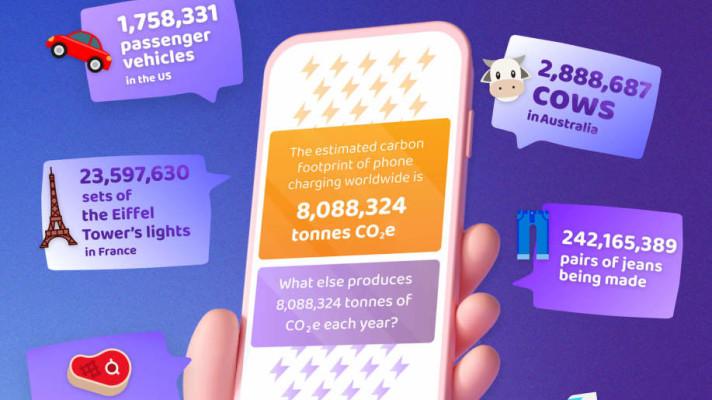Carbon footprint of charging phones
- Data released by comparethemarket.com.au shows that charging all the mobile phones in the world produces 8,088,324 tonnes of CO2e (carbon dioxide equivalent) per year
- The carbon footprint of global mobile phone charging is the same as other mass activities including feeding nearly one and a half billion people at a barbecue
New research from Compare the Market in Australia reveals that the carbon footprint of charging all the phones in the world is equivalent to nearly two billion passengers travelling on a bullet train in Japan, among other alternative activities.
By assuming that all phone users charge their mobiles for one hour per day, the global footprint of phone usage was determined and compared to other activities to showcase just how much of an impact phones can make on the environment.
Through an analysis of energy usage and carbon emissions in each continent, Compare the Market determined that the carbon footprint of global phone charging is equivalent to 8,088,324 tonnes of CO2e per year[1], which is also produced by the following activities:
- Running 1,758,331 passenger vehicles in the US[2]
- Powering 23,597,630 sets of the Eiffel Tower's lights[3]
- Making 242,165,389 pairs of jeans[4]
- Cooking 1,394,538,620 meals at a barbecue in the UK[5]
- Transporting 1,925,791,428 passengers on a bullet train in Japan[6]
- 2,888,687 cows living in Australia[7]
The carbon footprint of an activity refers to the total amount of greenhouse gases emitted[8], including carbon dioxide, nitrous oxide and methane.[9] Some scientists claim that concentrations of greenhouse gas drive complex shifts in climate change.[10] The Intergovernmental Panel on Climate Change concluded with 95 per cent certainty that human activity is the dominant cause of observed global warming over the past 50 years.[11]
Spokesperson for Compare the Market, Simon Downes, highlights the driving force behind collating the data.
"These fun and simple statistics are a great way to help consumers to better understand energy consumption," said Simon.
However, they also bring awareness to the environmental impact of phone usage.
"Charging one mobile phone presents little to no immediate harm to the environment - it is only when we look through a global lens that we see how significant that impact could be," he continues.
"Consumers should limit their energy usage and carbon footprint where possible, whether it be minimising the number of devices they use or switching to more energy efficient alternatives. Not only is that for the benefit of the environment, but also their own hip pockets."
For more information on the carbon footprint of phone charging including the full methodology and how calculations were made, visit comparethemarket.com.au.
[1] Calculations for the carbon footprint of mobile phone charging can be found at: https://www.comparethemarket.com.au/energy/carbon-footprint-of-phone-charging/
[2] United States Environmental Protection Agency - Greenhouse Gas Emissions form a Typical Passenger Vehicle: https://www.epa.gov/greenvehicles/greenhouse-gas-emissions-typical-passenger-vehicle
[3] TourEiffel.Paris - The Eiffel Tower's Illuminations: https://www.toureiffel.paris/en/the-monument/lights
[4] UN Environment Programme - Cleaning up couture: what's in your jeans?: https://www.unep.org/news-and-stories/story/cleaning-couture-whats-your-jeans
[5] The Royal Society - How much is your summer BBQ damaging the environment?: https://royalsociety.org/news/2019/07/summer-science-bite-out-of-climate-change/
[6] Central Japan Railway Company - Annual Report 2019: https://global.jr-central.co.jp/en/company/ir/annualreport/_pdf/annualreport2019.pdf
[7] Government of Western Australia - Carbon farming: reducing methane emissions from cattle using feed additives: https://www.agric.wa.gov.au/climate-change/carbon-farming-reducing-methane-emissions-cattle-using-feed-additives
[8] CO2 Australia - Defining 'Carbon Footprint': https://www.co2australia.com.au/defining-carbon-footprint/
[9] Investors in the Environment - How to calculate a basic carbon footprint: https://www.iie.uk.com/news/how-to-calculate-a-basic-carbon-footprint/
[10] National Geographic - Carbon dioxide levels are at a record high: https://www.nationalgeographic.com/environment/article/greenhouse-gases
[11] Intergovernmental Panel on Climate Change - Climate Change 2013: https://www.ipcc.ch/site/assets/uploads/2018/03/WG1AR5_SummaryVolume_FINAL.pdf
